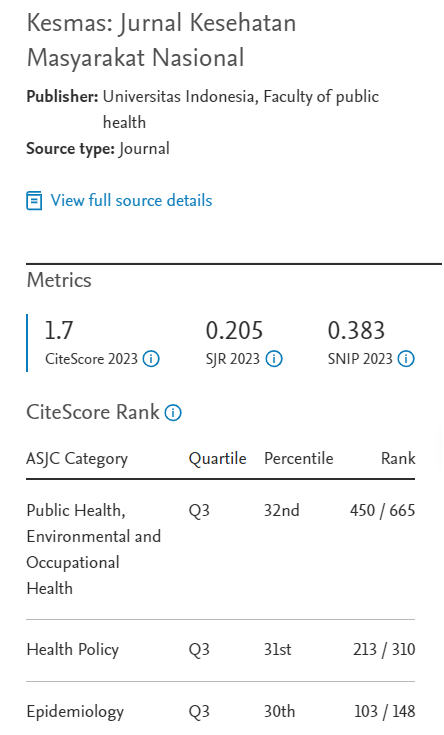Abstract
Occupational skin diseases are the most common work-related diseases in many countries. Shoe industry workers are potential to be affected by work-related skin diseases (WRSDs). This study aimed to analyze the risk factors associated with WRSDs among workers in the sewing section at a shoe company in West Java. A total of 477 workers were examined and interviewed using the modified Nordic Occupational Skin Questionnaire-2002/LONG from May 2016 to July 2016. Chi-square test and logistic regression were used to analyze the risk factors related to WRSDs. The results showed that 57.7% of the workers suffered from WRSDs. Most of the workers (71.7%) did not wear gloves while working; however, they washed their hands adequately at work (67.1%). Multivariate analysis indicated that a term of work, allergy records, organic dust exposure and duration of exposure per day, handwashing habits, and use of gloves while working were significant to WRSDs. Having allergy records and not wearing gloves were the two dominant factors associated with WRSDs (odds ratio: 6.743 and 6.224, respectively). Understanding the importance of using chemical protective gloves while working and washing hands with running water are essential for the proper implementation of protective measures to ensure worker's safety and health.
References
1. Darnton A. Work-related skin disease in Great Britain 2017. Health and Safety Executive [Internet]. 2017; 1: 1–9. Available from: www.hse.gov.uk/statistics/caudis/cancer/.
2. Held E, Mygind K, Wolff C, Gyntelberg F, Agner T. Prevention of work related skin problems: An intervention study in wet work employees. Occupational and Environmental Medicine. 2002; 59(8): 556–61.
3. Peate WF. Occupational skin disease. American Family Physician. 2002; 66(6): 1025–32.
4. Diepgen TL. Occupational skin diseases. Journal der Deutschen Dermatologischen Gesellschaft. 2012; 10: 297–315.
5. Cahill JL, Williams JD, Matheson MC, Palmer AM, Burgess JA, Dharmage SC, et al. Occupational skin disease in Victoria, Australia. Australasian Journal of Dermatology. 2016; 57: 108–14.
6. Nicholson P, Llewellyn D, English J. Evidence based guidelines for the prevention, identification and management of occupational contact dermatitis and urticaria. Contact Dermatitis [Internet]. 2010;63: 177–86. Available from: http://onlinelibrary.wiley.com/doi/10.1111/j.1600- 0536.2010.01763.x/full
7. Alfonso JH, Løvseth EK, Samant Y, Holm J-ø. Work-related skin diseases in Norway may be underreported: data from 2000 to 2013. Contact Dermatitis. 2015; 72 (6): 409 – 12.
8. Zorba E, Karpouzis A, Zorbas A, Bazas T, Zorbas S, Alexopoulos E, et al. Occupational dermatoses by type of work in Greece. Safety and Health at Work [Internet]. 2013; 4(3): 142–8. Available from: http://dx.doi.org/10.1016/j.shaw.2013.06.001
9. Febriana SA, Jungbauer F, Soebono H, Coenraads PJ. Occupational allergic contact dermatitis and patch test results of leather workers at two Indonesian tanneries. Contact Dermatitis. 2012; 67(5): 277–83.
10. Suryani F. Faktor-faktor yang berhubungan dengan terjadinya dermatitis kontak akibat kerja pada pekerja PT. Cosmar Indonesia Tangerang [Skripsi]. Jakarta: Universitas Islam Negeri; 2011.
11. Febriana SA, Soebono H, Coenraads PJ. Occupational skin hazards and prevalence of occupational skin diseases in shoe manufacturing workers in Indonesia. International Archive of Occupational and Environtmental Health. 2014; 87 (2): 185-94.
12. Sustaival P, Flyvholm MA, Meding B, Kanerva L, Lindberg M, Svensson A, et al. Nordic occupational skin questionnaire (NOSQ-2002): A new tool for surveying occupational skin diseases and exposure. Contact Dermatitis. 2003; 49: 70–6.
13. Islam LN, Sultana R, Ferdous KJ. Occupational health of the garment workers in Bangladesh. Journal of Environmental. 2014; 1(1): 21–4.
14. Fatma L, Utomo HS. Faktor-faktor yang berhubungan dengan dermatitis kontak pada pekerja di PT Inti Pantja Press Industri. Jurnal Makara Kesehatan. 2007; 11(2): 61–8.
15. Suwondo A, Jayanti S, Lestantyo D. Faktor-faktor yang berhubungan dengan kejadian dermatitis kontak pekerja industri tekstil di Jepara. Jurnal Kesehatan Masyarakat Indonesia. 2010; 6(2): 89-98.
16. Nurzakky M. Pengaruh kebiasaan mencuci tangan terhadap kejadian dermatitis kontak akibat kerja pada tangan pekerja bengkel di Surakarta [Skripsi]. Surakarta: Universitas Sebelas Maret; 2012.
17. Alchorne ADODA, Alchorne MMDA, Silva MM. Occupational dermatosis. Anais Brasileiros de Dermatologia. 2010; 85(2): 137-47.
18. Chen YX, Cheng HY, Li LF. Prevalence and risk factors of contact dermatitis among clothing manufacturing employees in Beijing: A crosssectional study. Medicine (Baltimore). 2017; 96 (12): 8.
19. Nuraga W, Lestari F, Kurniawidjaja LM, Dermatitis kontak pada pekerja yang terpajan dengan bahan kimia di Perusahaan Industri Otomotif Kawasan Industri C. Makara Journal of Health Research. 2008; 12 (2): 63–9.
20. Cahyawati IN. Dermatitis pada nelayan yang bekerja di Tempat Pelelangan Ikan (TPI) Tanjungsari [Thesis]. Semarang: Universitas Negeri Semarang; 2010.
Recommended Citation
Hendra H , Nirwana E , Isahak M ,
et al.
Work-Related Skin Diseases among Workers in the Sewing Section at PT. X Shoe Company in West Java.
Kesmas.
2018;
13(2):
60-64
DOI: 10.21109/kesmas.v13i2.1705
Available at:
https://scholarhub.ui.ac.id/kesmas/vol13/iss2/2
Included in
Biostatistics Commons, Environmental Public Health Commons, Epidemiology Commons, Health Policy Commons, Health Services Research Commons, Nutrition Commons, Occupational Health and Industrial Hygiene Commons, Public Health Education and Promotion Commons, Women's Health Commons







